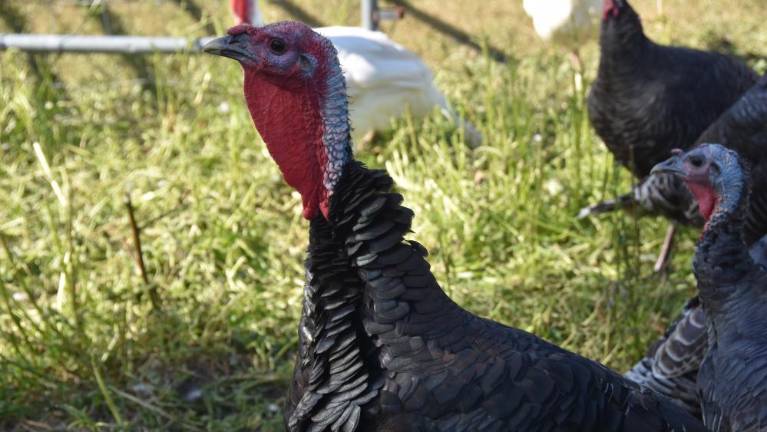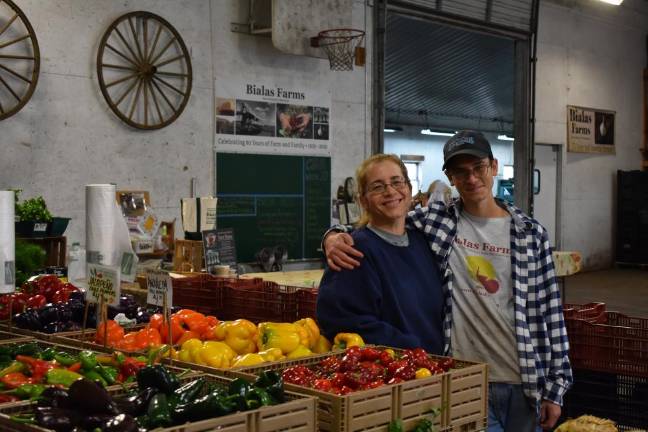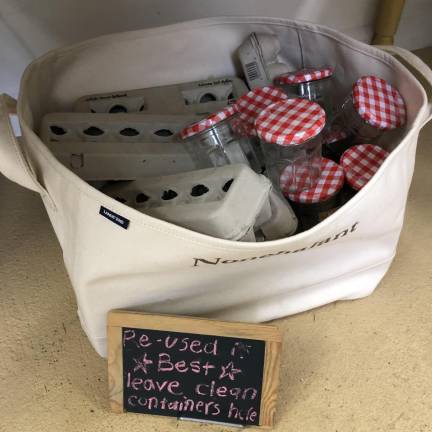Stressed supply chains make for priciest Thanksgiving meal ever
Holiday chow. From turkeys to Cholula hot sauce packets, costs are up and availability is down. Amid the chaos, local farmers have been “our rocks.”



This year’s Thanksgiving feast is on pace to be the costliest ever, starting with record-breaking price tags for turkeys. Shoppers are seeing an 18 percent increase over last year’s turkey prices at the grocery store, said Maire Ullrich, agricultural program leader at Cornell Cooperative Extension. For a frozen, 12-pound turkey, “you’re spending $16 instead of $13,” she said. Turkey prices, which are notoriously volatile, jumped by more than triple the galloping rate of inflation.
Local chains like ShopRite and Price Chopper that give away turkeys as a seasonal promotion are raising the dollar threshold customers need to spend to get their free birds, said Ullrich. “It shows up everywhere,” she said. “Food prices overall have seen this kind of increase.”
Customers who want a turkey will find one, said Ullrich. But there may be a shortage of parts, like turkey breasts, as well as of fresh turkeys, or really big or small ones. “All Americans are having to get used to not having exactly what we want — the depth, the breadth of every grocery aisle that we’ve gotten accustomed to,” Ullrich said. Food and beauty care giants like Proctor & Gamble have warned that they’ll continue raising their prices, in reacting to the higher cost of warehousing, raw material, and energy prices.
“It’s the perfect storm of a little bit of everything — processing plants shutting down and having to pay people more, fuel somewhat, feed prices absolutely are higher,” said Ullrich. Skyrocketing corn and soy prices are partly to blame on erratic weather, but primarily on mounting demand from China, she said. “We’ve been exporting a lot,” she said. “They’re a tremendous mouth to feed.” The cost of meat and eggs is up more than 10 percent over last year, according to the September consumer price index.
Now that prices have gone up, they’re not likely to come back down. “Everyone plans to stay there,” said Ullrich.
Local farmers slow to raise prices
For locally raised, pastured birds, which are already in a different price ballpark from a frozen Butterball, some farmers are opting to eat the cost increases rather than pass them along to customers. Susie Cleaver, owner of Banbury Cross Farm in Goshen, N.Y., is charging the same price she has for years – $5.50 a pound – for her heritage turkeys, which draw customers up from the city. The cost of shipping her non-GMO feed – which excludes grains that have been genetically modified to tolerate the heaviest doses of herbicides and pesticides – has about quadrupled, she said. Still, she said, “We felt that it’s hard enough. People are having a hard time this year with Covid and not working and everything else that it’s not fair to raise the price of the turkey.”
Bob Campbell is the longtime farm manager at Flatbrook Farm in Sandyston, N.J., which raises turkeys using a beyond-organic rotational grazing system comprised of movable hoop houses and electric netting. “You know, a 10-pound bird is $75 dollars,” he said. “That’s a lot of money for a turkey.” The farm is charging the same price as last year, $7.50 a pound for its pastured birds, notwithstanding the mutterings he’s been hearing about the “crazy” cost of their non-GMO turkey feed.
By November 2, every one of Flatbrook Farm’s 70 turkeys had been spoken for – weeks ahead of usual – and calls were still coming in, said Campbell. About 60 percent of their business comes from repeat customers, and the rest were new faces. There is clearly plenty of demand for sustainably raised birds in the hundred-plus dollar price range. Still, for those who are used to ShopRite prices, sticker shock is inevitable. Almost every year, said Campbell, they get the angry-husband customer, coming to the farm to pick up the turkey his wife ordered. When the husband sees the $150 price tag, said Campbell, “He says, ‘You can keep that,’ and he walks away.”
Animal feed of all kinds is way up, squeezing meat producers large and small. “And if you’re looking at organic or non-GMO turkey feed, the prices of that’s going to be even higher,” said Emily Shoop, a poultry educator with the Penn State Cooperative Extension. “Because it’s hard to source those ingredients in a normal year – and we haven’t had one of those in a while,” she laughed.
Last year’s growing season was stunted by drought through the mid-Atlantic, she said. This growing season – which will affect next year’s meat and egg prices – has also been marked by extremes. “This year it’s been pretty wet,” she said, “so folks haven’t been able to get into the fields to get crops off.”
‘I’ve been hopping suppliers and it’s getting dicey’
It’s not just the turkey that will be dearer this year. Pretty much everything on the Thanksgiving table is going to cost you more if it comes from far away, from the coffee to the disposable aluminum roasting pan. A step up the supply chain, farmers and restaurants are finding that goods they once considered basic — from vegetable seeds to plastic bags to compostable takeout containers — have gotten hard to find or shoddy, or else have doubled in price.
“I do find that the quality of things is down,” said farmer Jesse Clark of Nonchalant Cheese in Vernon, N.J. “Bread bags, for instance. I ordered exactly what I always order but I couldn’t get them in white so I ordered the brown. They were seriously inferior, and I ended up double bagging to make up for it. I don’t know if it’s the color or something else, but I see a lot of unpredictability like that.”
The pervasive issues with packaging might eventually turn out to have a silver lining. “There’s a little part of me that feels excited about it actually,” said Clark. “I like pushing boundaries and seeing how comfortable people are willing to be with re-use. If you can trust a restaurant to wash your plate and glassware, you should probably trust your farmer to wash that jelly jar before she refills it.”
Clark’s biggest challenge has been getting appointments with USDA butchers for her cows. “It’s never been easy but it’s ridiculous right now,” she said. “Butchers are so backed up that farmers are booking appointments for animals that haven’t been born yet.”
Kasha Bialas was surrounded by vibrant vegetables at her farm stand in the black dirt of New Hampton, N.Y., in early November. “I’m just looking around and I see plastic bags,” she said. “We prefer that people not use the plastic bags but they are an essential. So those things, the price has doubled. Those costs have to be passed on.”
Her son, Thomas Focarile, 17, was manning the farm stand until it was time to go home to do his calculus homework. “Plastic for our greenhouses more than doubled in a year’s time,” he said. “That’s a big difference.”
Kasha sometimes wonders if the cost increases are legitimate. “Or is it just, well I charge more,” she said. “I don’t like that.”
Bialas Farms, an 82-year-old family business, has responded to surprise costs by raising vegetable prices by a negligible amount — “maybe a nickel a pound or a quarter a bunch,” said Kasha. “It’s small potatoes compared to what people are paying elsewhere. But raising prices on a few items isn’t going to make up for a sub-par growing season.”
Local produce always gives you the most bang for your buck, she said, and this year only more so. Many of her customers stretch their dollars by getting creative with vegetable side dishes. “I imagine people with income insecurity will have a hard time coping with the letdown of not being able to afford the abundant holiday meal,” she said.
Kim Gabelmann, owner of Conscious Fork in Warwick, N.Y., is struggling to get the supplies she needs. “It’s becoming difficult to get our cups in the size we want, and since we would never use plastic, I’ve been hopping suppliers and it’s getting dicey,” she said. “Also we had to switch to different boxes/bowls for our food orders as they keep running out and we keep finding new replacements. But it adds to the challenge of running the biz. For some reason, Cholula hot sauce packets are hard to get!”
Conscious Fork’s main distributor, Baldor Foods, is delivering only two days a week because of a shortage of truck drivers. “They used to deliver to us every single day except Sunday,” said Gabelmann. “We used to have small minimums, and now they are large minimums. So we have to really understand what we need each week to maximize deliveries. And if they forget something or are out of something, it’s tough.”
The supply chain hiccups have forced food workers of all stripes to take a hard look at their sources: their carbon footprint, their reliability, the amount of labor involved in the handling. “For instance, avocados are a staple in vegan diet, but not really sustainable since it uses a high carbon footprint to bring here,” said Gabelmann. “It’s all related and keeps me thinking about the business supply chains. We use avocado in so many dishes, and I’m afraid that doesn’t make much sense anymore. Yum tofu!”
Brittany Hiller, the chef and owner of Fannie’s in Warwick, N.Y., had to raise items on her Thanksgiving catering menu $2 apiece, but only because the packaging went up so much: compostable to-go boxes, “and even the crappy foil ones I hate using are just as expensive,” she said. “Brown paper bags – big ones? Forget it.”
But her reliance on local farmers, always a core tenet, is paying off. They get all of their vegetables from J&A Farm in Goshen, N.Y., and chickens for stock and gravy from Hillery Farms in Pine Island, N.Y. “All our local farmers haven’t raised prices much or stopped delivering to us,” she said. “They’re our rocks!”
“It’s never been easy but it’s ridiculous right now. Butchers are so backed up that farmers are booking appointments for animals that haven’t been born yet.” Jesse Clark

